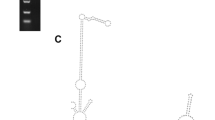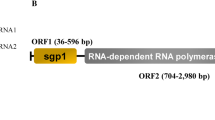Abstract
The bisegmented genome of a novel double-stranded (ds) RNA mycovirus, named “Aspergillus nidulans partitivirus 1” (AnPV1), isolated from the fungus Aspergillus nidulans strain HJ5-47, was sequenced and analyzed. AnPV1 contains two segments, AnPV1-1 and AnPV1-2. AnPV1-1 has 1837 bp with an open reading frame (ORF) that potentially encodes a putative RNA-dependent RNA polymerase (RdRp) of 572 amino acids (aa). AnPV1-2 has 1583 bp with an ORF encoding a putative capsid protein (CP) of 488 aa. Phylogenetic analyses indicated that AnPV1 and related viruses clustered in a group that could represent a new unclassified genus in the family Partitiviridae.



Similar content being viewed by others
References
Rokas A (2013) Aspergillus. Curr Biol 23:R187–R188
Galagan JE, Calvo SE, Cuomo C, Ma LJ, Wortman JR, Batzoglou S, Kapitonov V (2005) Sequencing of Aspergillus nidulans and comparative analysis with A. fumigatus and A. oryzae. Nature 438:1105–1115
Liu L, Xie J, Cheng J, Fu Y, Li G, Yi X, Jiang D (2014) Fungal negative-stranded RNA virus that is related to bornaviruses and nyaviruses. Proc Natl Acad Sci USA 111:12205–12210
Yu X, Li B, Fu Y, Jiang D, Ghabrial SA, Li G, Yi X (2010) A geminivirus-related DNA mycovirus that confers hypovirulence to a plant pathogenic fungus. Proc Natl Acad Sci USA 107:8387–8392
Ghabrial SA, Suzuki N (2009) Viruses of plant pathogenic fungi. Annu Rev Phytopathol 47:353–384
Zhang R, Hisano S, Tani A, Kondo H, Kanematsu S, Suzuki N (2016) A capsidless ssRNA virus hosted by an unrelated dsRNA virus. Nat Microbiol 1:1–6
Yu X, Li B, Fu Y, Xie J, Cheng J, Ghabrial SA, Jiang D (2013) Extracellular transmission of a DNA mycovirus and its use as a natural fungicide. Proc Natl Acad Sci USA 110:1452–1457
Anagnostakis SL (1982) Biological control of chestnut blight. Science 215:466–471
Xie J, Jiang D (2014) New insights into mycoviruses and exploration for the biological control of crop fungal diseases. Annu Rev Phytopathol 52:45–68
Kotta-Loizou I, Coutts RH (2017) Mycoviruses in Aspergilli: a comprehensive review. Front Microbiol 8:1699
Nibert ML, Ghabrial SA, Maiss E, Lesker T, Vainio EJ, Jiang D, Suzuki N (2014) Taxonomic reorganization of family Partitiviridae and other recent progress in partitivirus research. Virus Res 188:128–141
Vainio EJ, Chiba S, Ghabrial SA, Maiss E, Roossinck M, Sabanadzovic S, Nibert M (2018) ICTV virus taxonomy profile: Partitiviridae. J General Virol 99:17–18
Jiang Y, Wang J, Yang B, Wang Q, Zhou J, Yu W (2019) Molecular characterization of a debilitation-associated partitivirus infecting the pathogenic fungus Aspergillus flavus. Front Microbiol 10:626
Nerva L, Silvestri A, Ciuffo M, Palmano S, Varese GC, Turina M (2017) Transmission of Penicillium aurantiogriseum partiti-like virus 1 to a new fungal host (Cryphonectria parasitica) confers higher resistance to salinity and reveals adaptive genomic changes. Environ Microbiol 19:4480–4492
Shi M, Lin XD, Tian JH, Chen LJ, Chen X, Li CX, Buchmann J (2016) Redefining the invertebrate RNA virosphere. Nature 540:539–543
Dodds JA, Bar-Joseph M (1983) Double-stranded RNA from plants infected with closteroviruses. Phytopathology 73:419–423
Morris TJ, Dodds JA (1979) Isolation and analysis of double-stranded RNA from virus-infected plant and fungal tissue. Phytopathology 69:854–858
Jiang Y, Zhang T, Luo C, Jiang D, Li G, Li Q, Huang J (2015) Prevalence and diversity of mycoviruses infecting the plant pathogen Ustilaginoidea virens. Virus Res 195:47–56
Potgieter AC, Page NA, Liebenberg J, Wright IM, Landt O, Van Dijk AA (2009) Improved strategies for sequence-independent amplification and sequencing of viral double-stranded RNA genomes. J General Virol 90:1423–1432
Tamura K, Stecher G, Peterson D, Filipski A, Kumar S (2013) MEGA6: molecular evolutionary genetics analysis version 6.0. Mol Biol Evol 30:2725–2729
Wang L, Jiang J, Wang Y, Hong N, Zhang F, Xu W, Wang G (2014) Hypovirulence of the phytopathogenic fungus Botryosphaeria dothidea: association with a coinfecting chrysovirus and a partitivirus. J Virol 88:7517–7527
Zoll J, Verweij PE, Melchers WJ (2018) Discovery and characterization of novel Aspergillus fumigatus mycoviruses. PLoS ONE 13:e0200511
Bruenn JA (1993) A closely related group of RNA-dependent RNA polymerases from double-stranded RNA viruses. Nucleic Acids Res 21:5667–5669
Ghabrial SA (1998) Origin, adaptation and evolutionary pathways of fungal viruses. Virus Genes 16:119–131
Coutts RH, Covelli L, Di Serio F, Citir A, Açıkgöz S, Hernández C, Raqozzino A, Flores R (2004) Cherry chlorotic rusty spot and Amasya cherry diseases are associated with a complex pattern of mycoviral-like double-stranded RNAs. II. Characterization of a new species in the genus Partitivirus. J Gen Virol 85:3399–3403
Liu H, Fu Y, Xie J, Cheng J, Ghabrial SA, Li G, Peng Y, Yi X, Jiang D (2012) Evolutionary genomics of mycovirus-related dsRNA viruses reveals cross-family horizontal gene transfer and evolution of diverse viral lineages. BMC Evol Biol 12:91
Funding
This study was funded by the National Natural Science Foundation of China (31660012 and 32000017), the Science and Technology Foundation of Guizhou Province [(2019)1277], the Regional Common Diseases and Adult Stem Cell Transformation Research and Innovation Platform of Guizhou Provincial Department of Science and Technology [(2019)4008], the Joint Foundation of Collaboration Project between Scientific and Technological Bureau of Guizhou Province and Universities of Guizhou Province [LH(2016)7348], the Joint Foundation of Collaboration Project between Scientific and Technological Bureau of Guiyang City and Guizhou Medical University [(20161001)032], and the Youth Science and Technology Talent Development Project from Guizhou Provincial Department of Education [KY(2016)146].
Author information
Authors and Affiliations
Corresponding author
Ethics declarations
Conflict of interest
The authors declare no conflict of interest.
Ethical approval
This article does not contain any studies with human participants or animals performed by any of the authors.
Additional information
Handling Editor: Ioly Kotta-Loizou.
Publisher's Note
Springer Nature remains neutral with regard to jurisdictional claims in published maps and institutional affiliations.
Supplementary Information
Below is the link to the electronic supplementary material.

F
ig. S1 Phylogenetic analysis based on CP sequences of AnPV1 and other members of the family Partitiviridae. The maximum-likelihood tree was constructed in MEGA 6.06 with 1000 bootstrap replicates. GenBank accession numbers are shown before the virus names in the tree. Helminthosporium victoriae virus 190S, a member of the genus Totivirus in the family Totiviridae, was used to root the tree. The arrow indicates the position of AnPV1. (JPG 2692 KB)

F
ig. S2 Agarose gel electrophoresis of the cDNA of AnPV1-1 and AnPV1-2. (JPG 303 KB)
Rights and permissions
About this article
Cite this article
Jiang, Y., Yang, B., Liu, J. et al. A novel mycovirus infecting Aspergillus nidulans that is closely related to viruses in a new genus of the family Partitiviridae. Arch Virol 166, 659–664 (2021). https://doi.org/10.1007/s00705-020-04930-x
Received:
Accepted:
Published:
Issue Date:
DOI: https://doi.org/10.1007/s00705-020-04930-x




